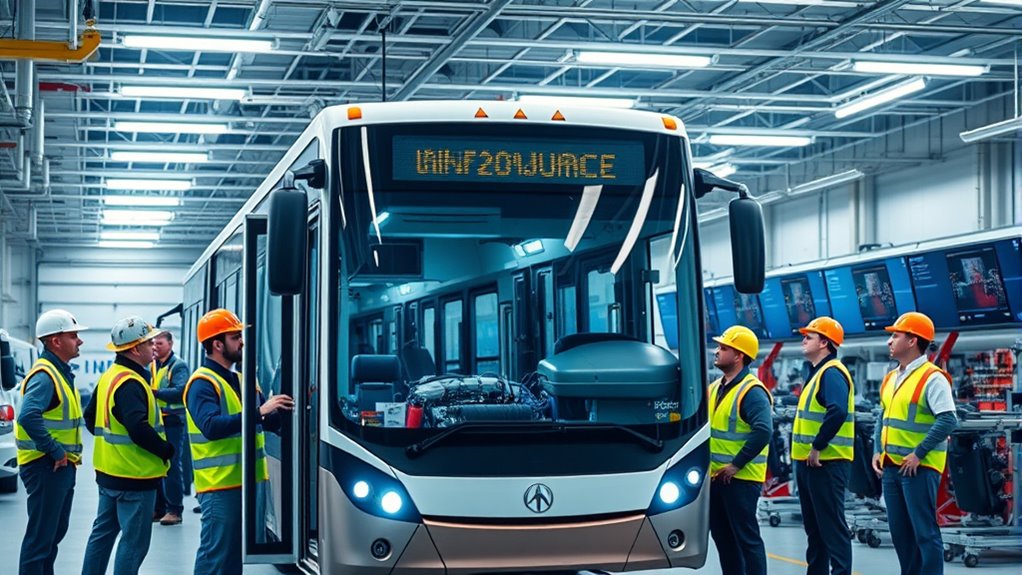Training staff for electric bus operations presents key challenges, including mastering high-voltage safety, battery management, and energy systems. You need to bridge skill gaps from traditional diesel work to advanced electrical diagnostics, often relying on inconsistent OEM programs. Adapting to charging infrastructure, operational protocols, and emerging technology can be complex. Ongoing education and safety reinforcement are essential. Exploring solutions will help you better understand how to address these obstacles effectively and keep your fleet running smoothly.
Key Takeaways
- Workforce skill gaps due to reliance on traditional diesel technician training and lack of standardized electric vehicle curricula.
- Ensuring safety awareness, especially high-voltage safety, requires specialized, ongoing training beyond basic operational skills.
- Training staff on complex energy management, charging protocols, and fault diagnosis presents technical challenges.
- Addressing workforce diversity and accessibility issues through inclusive training programs and partnerships remains difficult.
- Keeping staff updated on evolving technologies, safety standards, and software systems demands continuous, adaptable education efforts.

As electric bus operations become more widespread, thorough staff training is essential to guarantee safety, efficiency, and reliability. Transitioning from traditional diesel fleets to electric vehicles introduces a host of technical, safety, and operational challenges that require a well-structured training approach. Developing industry-first electric school bus training standards helps you understand core competencies across operations, safety, and maintenance. These standards, informed by reputable frameworks like APTA, ASE, and EVSC, ensure you gain the necessary technical proficiency while maintaining safety. They’ve been peer-reviewed by over 50 experts, including operators, manufacturers, and subject specialists, giving you confidence that the training is comprehensive and reliable.
Your training programs need to adapt existing EV frameworks to the specific needs of school bus operations, emphasizing not only technical skills but also equity and accessibility. This means multilingual support and accommodations for learning differences, ensuring all staff members can participate fully regardless of background or ability.
Safety protocols are a critical part of your training, especially around high-voltage systems. Level I training introduces you to high-voltage safety awareness, OEM-specific orientations, and bus systems. Level II explores more deeply into battery systems, lockout/tagout procedures, and personal protective equipment for high-voltage tasks.
You’ll learn to perform zero-voltage verification and live-work protocols, which are mandated for HV work, reducing risks during maintenance or emergencies. Collaborating with OEMs helps improve safety features and makes components more accessible, but it’s your ongoing responsibility to stay updated on policies and best practices. Safety isn’t a one-time lesson; it’s an ongoing commitment reinforced through policy monitoring and task-specific personnel assignments.
Charging infrastructure management poses additional hurdles. You must learn to develop charging schedules based on State of Charge (SOC), electricity costs, and driver availability. Route optimization needs to account for battery range and charging opportunities, requiring you to understand energy storage system maintenance and performance monitoring. Additionally, industry standards help ensure that charging practices align with current safety and efficiency guidelines.
Protocols for charger maintenance, fault diagnosis, and grid-load management are vital to prevent operational disruptions. Connecting with utility programs can help reduce operational costs during off-peak hours, but you need to stay informed about evolving energy policies and technology updates.
The shift to electric buses also exposes skill gaps among traditional diesel technicians, who need retraining on high-voltage systems, battery diagnostics, and thermal management for battery longevity. The lack of standardized curricula means you often rely on OEM-specific training, which can be inconsistent. Incorporating specialized Mazda Tuning techniques and tools can further enhance troubleshooting and performance optimization.
You’ll need cross-disciplinary skills spanning electrical engineering and software diagnostics to troubleshoot complex systems effectively. Additionally, addressing workforce equity involves creating accessible training programs for staff with childcare needs, language barriers, or learning disabilities. Partnerships with vocational schools and subsidies for low-income trainees help diversify and strengthen your workforce.
Finally, managing operational transitions requires phased training for drivers, mechanics, and support staff to avoid service disruptions. Integrating data from telematics, charging software, and fleet management systems presents technological challenges. Cold climates further complicate battery performance, demanding specific operational adjustments.
Simulation tools and practical training are invaluable, helping you meet accident avoidance requirements and emergency protocols. Navigating these challenges demands strategic planning, ongoing education, and a focus on safety and inclusivity to ensure a successful transition to electric bus operations.
Frequently Asked Questions
How Long Does Electric Bus Operator Training Typically Take?
You’ll find that electric bus operator training generally takes around 7 to 10 weeks. It starts with 2–3 weeks of classroom and theoretical instruction covering policies, safety, and regulations.
Then, you’ll spend 1–2 weeks on simulators and controlled driving practice.
Preparing for your CDL takes about 3–4 weeks, followed by 2 weeks of on-the-job training, route familiarization, and gaining confidence in real-world scenarios.
What Are the Costs Associated With Electric Bus Staff Training?
You might wonder about the costs of training your staff for electric buses. While some programs, like free online courses or no-cost pre-training, keep expenses low, extensive in-person training can cost over $10,000 per student, especially for advanced skills.
Funding options, grants, and community partnerships can help reduce these costs. But balancing quality training with budget constraints remains a challenge you’ll need to navigate carefully.
How Do Training Needs Differ Between Electric and Diesel Bus Staff?
You need to recognize that training for electric buses differs markedly from diesel ones. You’ll focus more on mastering regenerative braking, energy conservation, and interpreting new dashboard indicators.
Maintenance shifts to battery safety and thermal management, requiring electrical safety protocols and software diagnostics.
Safety procedures emphasize high-voltage handling and fire response.
Additionally, you’ll need skills in charging infrastructure, grid management, and telematics, unlike traditional diesel operation and maintenance.
Are There Certification Requirements Specific to Electric Bus Operators?
You need to know that electric bus operators face specific certification requirements, including obtaining a Commercial Driver License with passenger endorsement and completing mandated safety training like PJ’s Law.
Additionally, you must pass biennial road tests and exams per Article 19-A.
Safety certifications for handling high-voltage systems and lithium-ion batteries are also essential.
These certifications guarantee you’re qualified to operate and maintain electric buses safely and meet all regulatory standards.
How Frequently Should Staff Retrain on Electric Bus Technology Updates?
You should retrain staff on electric bus technology updates regularly to keep pace with evolving trends. For new battery chemistries and infrastructure changes, annual or biannual retraining is recommended.
Additionally, every 2-3 years, update training related to battery size, range, and emerging tech.
Stay current with regulatory changes and safety standards, which often require recertification every 1-2 years, ensuring your team maintains ideal knowledge and safety compliance.
Conclusion
Just like Icarus had to learn how to navigate the sun’s heat without flying too close, you must master the delicate balance of training for electric bus operations. Embrace the challenge, knowing that every lesson learned brings you closer to sustainable transit success. Remember, the journey may be complex, but with patience and innovation, you’ll soar beyond obstacles—turning the promise of electric buses into a reality that benefits all.









